In the vast sands of ancient Egypt, where the Nile flows serenely, there lies a story deeply intertwined with the foundation of existence itself—a tale of Ptah, the creator god, the divine craftsman, and the architect of the cosmos. This is not merely a myth but a saga of creativity, will, and the power of spoken word. As a central figure in Egyptian theology, Ptah’s legacy is one of ingenuity and profound wisdom, embodying the belief that thoughts and words have the power to manifest reality. The sun had not yet risen, and the universe was a void. In the infinite silence, Ptah emerged as a being of supreme intellect and intent. Unlike the chaotic forces that shaped many other creation myths, Ptah’s method was unique. Through the sheer force of will and the precision of his spoken words, he created the heavens, the earth, and all that exists within. Standing in the primordial waters of Nun, Ptah envisioned the world in his heart—a sacred act of divine imagination. His thoughts, pure and untainted, were vocalized with clarity, giving shape to the formless. "Let there be light," he proclaimed, and the world illuminated with the brilliance of Ra, the sun god. Each word he spoke resonated across the void, manifesting mountains, rivers, plants, and living beings. Ptah was not just a creator; he was an artisan. His hands shaped the first mound of earth, forming it like a potter crafting clay. From his lips came the hieroglyphs, symbols that contained the secrets of life and governance, granting humanity the tools of communication and culture. The sacred city of Memphis became the heart of Ptah’s worship. Known as "Hwt-ka-Ptah," meaning "The Mansion of the Soul of Ptah," Memphis was a marvel of civilization. It was said that Ptah himself laid the foundation of the city, designing its temples, workshops, and infrastructure with precision that reflected divine order. The Great Temple of Ptah stood as a testament to his creative might. The temple’s columns, adorned with carvings of lotus and papyrus, symbolized the unification of Upper and Lower Egypt. It was here that priests, artists, and craftsmen gathered to pay homage to their divine inspiration. The rituals performed within the temple echoed Ptah’s act of creation, as priests recited sacred texts, invoking his blessings for fertility, prosperity, and protection. Ptah’s role extended beyond the act of creation. He was the father of the other gods, the Netjeru, whose existence was tied to his vision. Among his creations were Sekhmet, the fierce lion-headed goddess of war, and Nefertem, the youthful god of healing and beauty. Together, they formed the Memphite Triad, a divine family revered across Egypt. Each deity owed their purpose to Ptah’s will. Sekhmet was born from the fiery breath of Ptah, designed to protect Ma’at, the cosmic balance. Her strength was unmatched, and her loyalty to Ptah was unwavering. Nefertem, on the other hand, emerged as a symbol of renewal and healing, his fragrance likened to the blooming lotus that heralded the dawn. Ptah’s influence extended to Osiris, Isis, Horus, and Set, ensuring harmony among the divine realms. He often mediated conflicts among the gods, using wisdom rather than force, a reflection of his creative nature. As the patron of craftsmen and builders, Ptah’s teachings transformed ancient Egypt into a land of awe-inspiring architecture and artistry. It was believed that every sculpture, monument, or temple created by human hands was a tribute to Ptah. Artisans would invoke his name before beginning their work, seeking his guidance to imbue their creations with life. The Pyramids of Giza, though attributed to the pharaohs, were seen as inspired by Ptah’s divine design. The Great Sphinx, with its enigmatic gaze, was said to guard the mysteries of creation, echoing Ptah’s wisdom. Ptah’s compassion extended beyond the gods to mortals. He provided humanity with tools and knowledge, enabling them to build cities, cultivate the land, and establish trade. Farmers would pray to Ptah for fertile soil, while architects sought his blessings for stability in their constructions. Legends tell of Ptah descending to the mortal world in the guise of a humble craftsman, teaching the first blacksmiths to forge tools and weapons. He was revered as a god who understood the struggles of humanity and offered solutions through ingenuity and hard work. Ptah’s influence endured throughout Egypt’s history. Pharaohs proclaimed themselves as chosen by Ptah, constructing magnificent temples in his honor. His priests became advisors to kings, their wisdom guiding the affairs of state. In art, Ptah was depicted as a mummified figure, holding a scepter that symbolized stability, dominion, and power. His serene expression conveyed the calm confidence of a creator who understood the balance of the universe. The story of Ptah is not merely a tale of creation but a reminder of the power of thought, words, and craftsmanship. He represents the boundless potential within every individual to create, innovate, and transform their world. Even as time marched forward and the sands of Egypt shifted, Ptah’s legacy remained etched in stone and memory. His temples, his teachings, and his creations continue to inspire those who seek the divine spark within themselves.The Dawn of Ptah’s Creation
Ptah’s City: Memphis
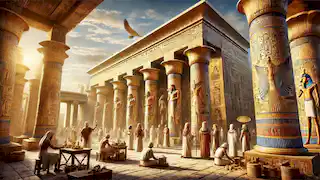
Ptah and the Netjeru (Gods)
The Sacred Art of Creation
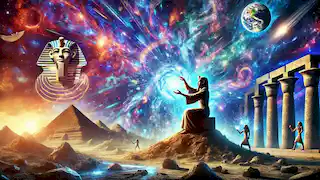
Ptah and the Mortal World
The Legacy of Ptah
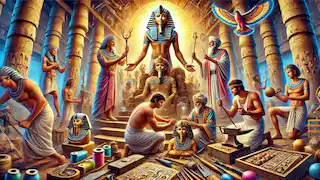
The Eternal Flam10
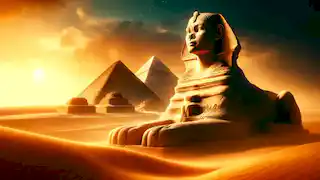
The Story of Ptah
Reading Time: 5 min
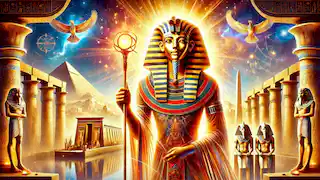
About Story: The Story of Ptah is a Myth Stories from egypt set in the Ancient Stories. This Descriptive Stories tale explores themes of Wisdom Stories and is suitable for All Ages Stories. It offers Cultural Stories insights. The tale of Ptah, Egypt's divine creator, celebrates the power of words and craftsmanship.

















